| Your browser is not supported. | ||
|
Please browse our site using any of the following options:
| ||
A Guide On Choosing And Buying A Camping Tent
Getting back to nature is good for the soul, and camping is a cheap way to get away, recharge, and reconnect with loved ones. You'll need a tent, but what tent should you buy for camping? Anaconda's Tent Buying Guide talks you through everything you need to consider to choose the best tent for your needs so you're a happy camper.
What is the best tent for camping?
Everyone's different, and like many things in life, what's best for one person might not be best for the next. The best tent for you depends on your particular camping needs:
- Where you'll be using the tent (weather conditions on this and future camping trips)
- Who you'll camp with (now and in the future - any kids, bad sleepers, tall campers?)
- How easy you want it to be to put the tent up and pack it down (alone or with help)
- How often you'll be camping and for how long (on weekends only or for a few weeks?)
- How long you want it to last (for a few short trips or for many years of camping?)
What tent should you buy for camping?
Working out which tent to buy is easier when you break it down in into these six steps:
1. Weather
What type of tent do you need for camping in different weather conditions?
How well your tent handles the weather can make or break a camping trip. Having the right tent for the weather you'll be facing - hot, cold, rain or snow - will ensure you're comfortable and sleep well. A tent that can't handle the conditions can lead to an uncomfortable night in the car or a midnight dash to the nearest motel.
Tents all have a rating that tells you how many seasons they're suitable for camping in:
| Season Rating | 1 Season | 2 Season | 3 Season | 4 Season | 5 Season |
| Summer | X | X | X | ||
| Autumn | X | X | X | ||
| Spring | X | X | X | ||
| Winter | X | ||||
| Extreme Expeditions | X | ||||
| Conditions these type of tents are designed to withstand: | |||||
| Rain | Light Showers | Showers | Moderate Rain | Heavy Rain | Extremely Heavy Rain |
| Snow | Very Light Snow | Heavy Snow | Extremely Heavy Snow | ||
| Wind | Mild Wind | Strong Wind | Extremely Strong Winds | ||
| These are: | Most Popular & Most Family Tents | May be too hot in summer | For extreme high altitude expeditions | ||
Best waterproof tents
When it comes to tents labelled waterproof, some are more waterproof than others:
- The water (or hydrostatic) head rating tells you how waterproof the tent/fly is.
- The higher the water/hydrostatic head rating, the more waterproof it will be.
- If you want one of the best waterproof tents, choose one with one of the highest water/hydrostatic head ratings for both the tent/fly fabric and floor fabric.
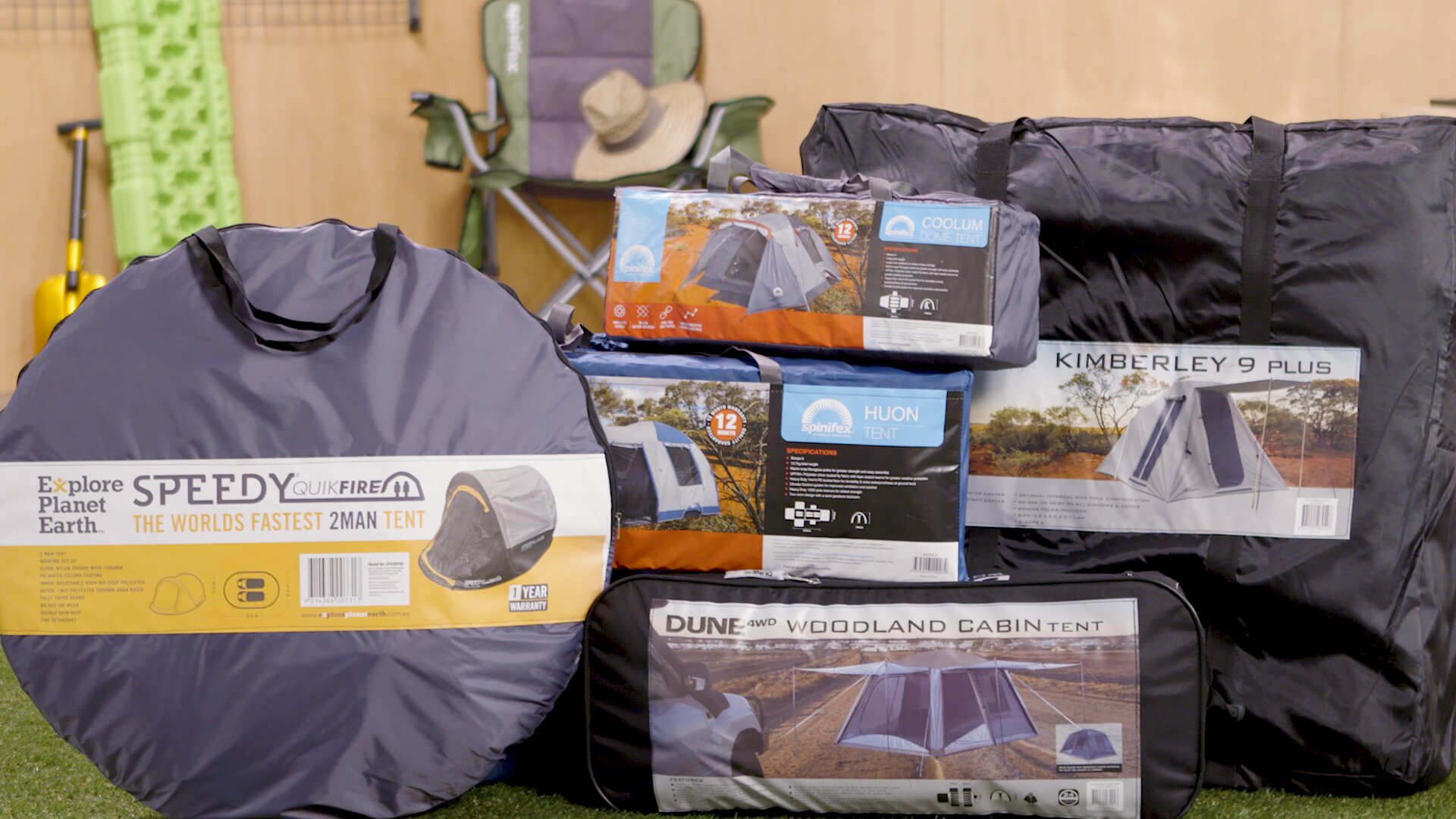
2. Size
Tents range in size from 1-12 person tents, and most family tents are for 3-10 people. However, choosing the right size tent isn't as simple as buying a two-person tent for two campers, or a four-person tent for four, as these numbers only allow for tightly packed bodies in sleeping bags, nothing else.
In addition to people, you may want to ensure there's enough space in your tent for:
- Bags - how many bags you'll have to fit inside the tent and what size they'll be.
- Beds - your tent needs to be long and wide enough to fit any airbeds or stretchers.
- Height - the tent has to be long enough for anyone tall to sleep with straight legs.
- Boots - if you want them inside overnight, and away from creepy crawlies and rain.
- Gear - anything else you want to keep safe inside the tent while you sleep at night.
- Moving - more floor and head space makes dressing and getting in and out easier.
Unless you're carrying your tent and need it to be as light as possible, consider choosing a tent that's designed to sleep 1-2 more people than you'll have camping so you have enough space for everything and don't feel too cramped.
Also factor in:
- If the tent bag will fit in your boot, roof racks or the back of the truck.
- How big your campsite will be - make sure your tent fits in the site measurements.
- If there's likely to be extras (kids, friends and family) sleeping in your tent in future.
- A tent with more than one entry/exit point so getting in and out is easy (you won't have to climb over each other in the middle of the night for the toilet).
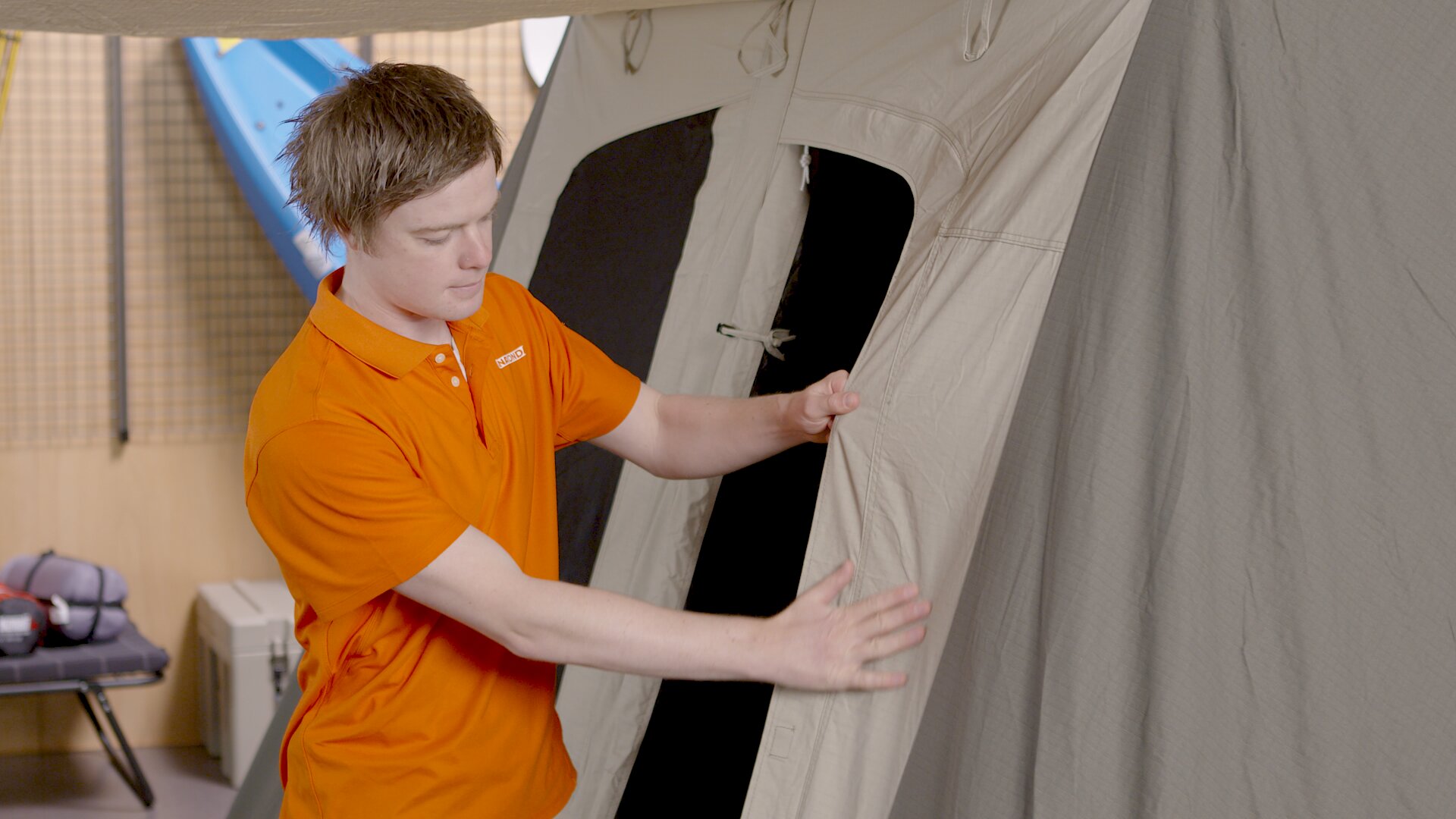
3. Set-Up Simplicity
How easy do you want setting up the tent to be, and packing it up when it's home time?
It's important to think about:
- Whether you'll be doing it all alone or if you'll have other (adult) helpers.
- Some big, family tents take a long time to set up and you need lots of help.
- Other tents have Instant Up Technology and simply pop-up in 1-3 minutes. This is a great option if you're thinking 'how do you set up a camping tent?'
- A swag simply rolls out and is perfect if you just want to crawl in and sleep.
- Arriving at the camp site with enough time to set up your tent while it's still light.
- Doing trial runs at home so the set up and pack up isn't stressful on camping trips.
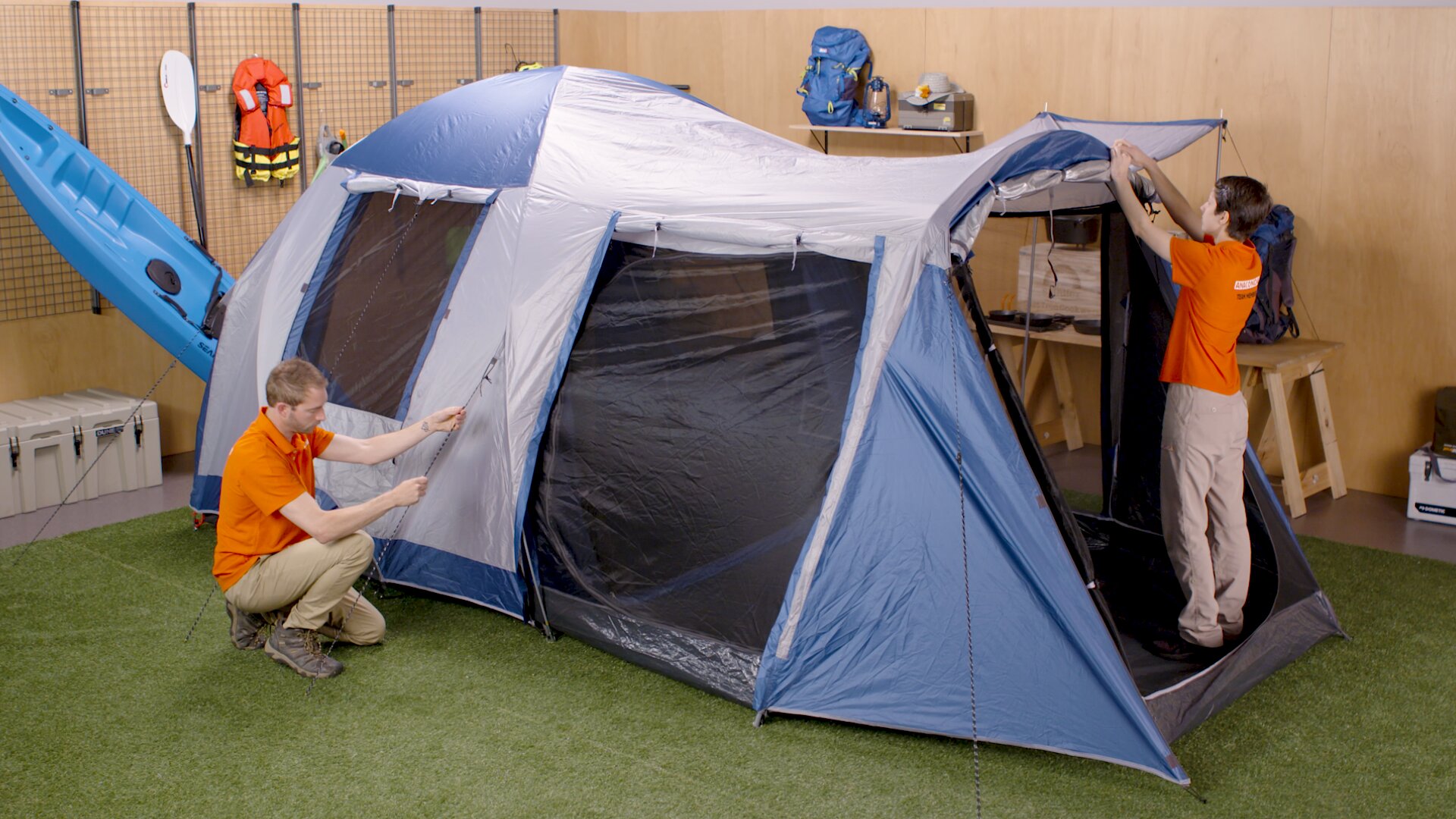
4. Parts
The 10 Parts of a Tent
- Vestibule/awning: Creates an undercover living/storage space that's weather protected.
- Poles: These form the basic structure of your tent and give it its shape.
- Pegs: Keep the tent and the fly securely attached to the ground.
- Ropes: Connect the fabric to the pegs so everything's stable and the rain runs off.
- Floor: Stops the rain water on the ground getting in and keeps you dry.
- Footprint/tarp (optional extra): Extra under-floor protection to prevent water seeping in and fabric ripping.
- Bag: Keeps all your tent parts together, safe and easily transportable.
The Importance of Tent Parts
Fabric
The materials a tent is made from determines how sturdy, weatherproof and long-lasting the tent will be.
- Nylon
- Waterproof (if the seams are sealed)
- Thin and light so good for backpacking
- May have a coating for UV protection and durability
- Deteriorates with sun exposure over time
- Polyester
- Waterproof (if the seams are sealed)
- Thicker and longer lasting than nylon
- Handles sun exposure better than nylon
- May have a breathable coating that reduces condensation damp
- Canvas/cotton
- Waterproof (after it's been wet or seasoned once)
- Long-lasting for years of camping
- Breathable so cool in summer and warm in winter
- Heavy (especially when wet)
- Polycotton
- Lighter than cotton and strong
- Usually has a waterproof coating
Also think about the fabric's:
- Light blocking
- All Coleman tents have Dark Room™ technology that:
- Blocks 95% of sunlight so you can get the kids to sleep before it's dark and they won't wake you up at the crack of dawn.
- Reduces the heat by up to 5 degrees in summer and keeps you warmer when it's cold outside.
- UV protection - so the tent's fabric protects you from the sun's harsh UV rays.
- Thread count
- Like sheets, the higher the thread count, the more breathable the fabric is.
- It's not relevant to how waterproof a tent is, only how heavy and breathable.
- Weight
- The fabric's thickness is given in denier (D).
- A higher D tent is more waterproof and able to handle stronger winds.
- A low denier fabric is lighter and less durable than a higher denier tent fabric.
- Durability - RipStop fabric helps prevent rips so your tent lasts longer.
| Cotton, Canvas, Polycotton | Nylon, Polyester | |
| Most waterproof (once weathered/seasoned) | X | |
| Fastest Drying | X | |
| Sturdiest | X | |
| Lightest | X | |
| Most breathable & least condensation | X | |
| Coolest in the sun & warmest at night | X | |
| Mould & Mildew maintenance required | X | |
| Cheapest | X | |
| Longest lasting | X |
Zippers
Good quality, non-rusting zips are essential if you want to:
- Keep the creepy crawlies out.
- Have a tent that will last.
Ventilation
Some tents have mesh door and window ventilation flaps that:
- Give you a cool breeze flowing through the tent on hot nights to help you sleep.
- Help prevent moist air from being trapped in the tent, which can cause condensation, making your tent and everything in it feel damp when you wake up.
- Mean they're not as watertight as tents without ventilation, so it's worth weighing up this trade-off based on how hot and rainy your camping weather will be.
Fly
The fly covers your tent (and preferably all the windows and doors too):
- It has a waterproof silicon or polyurethane coating to protect the tent from rain.
- The seams on the fly need to be sealed with tape to prevent water seeping into your tent.
- Needs to be pegged away from the tent floor so:
- Rain doesn't run down the fly and into your tent.
- There's enough airflow to prevent condensation damp.
Poles
Better quality poles last longer and won't snap when it gets windy:
- Carbon fibre - extremely light and strong, but not as long-lasting as aluminium.
- Aluminium - stronger and lighter than fibreglass - lasts longer than carbon fibre.
- Fibreglass - heavier and doesn't last as long as aluminium and carbon fibre poles.
Poles can be attached to the fabric and fly using:
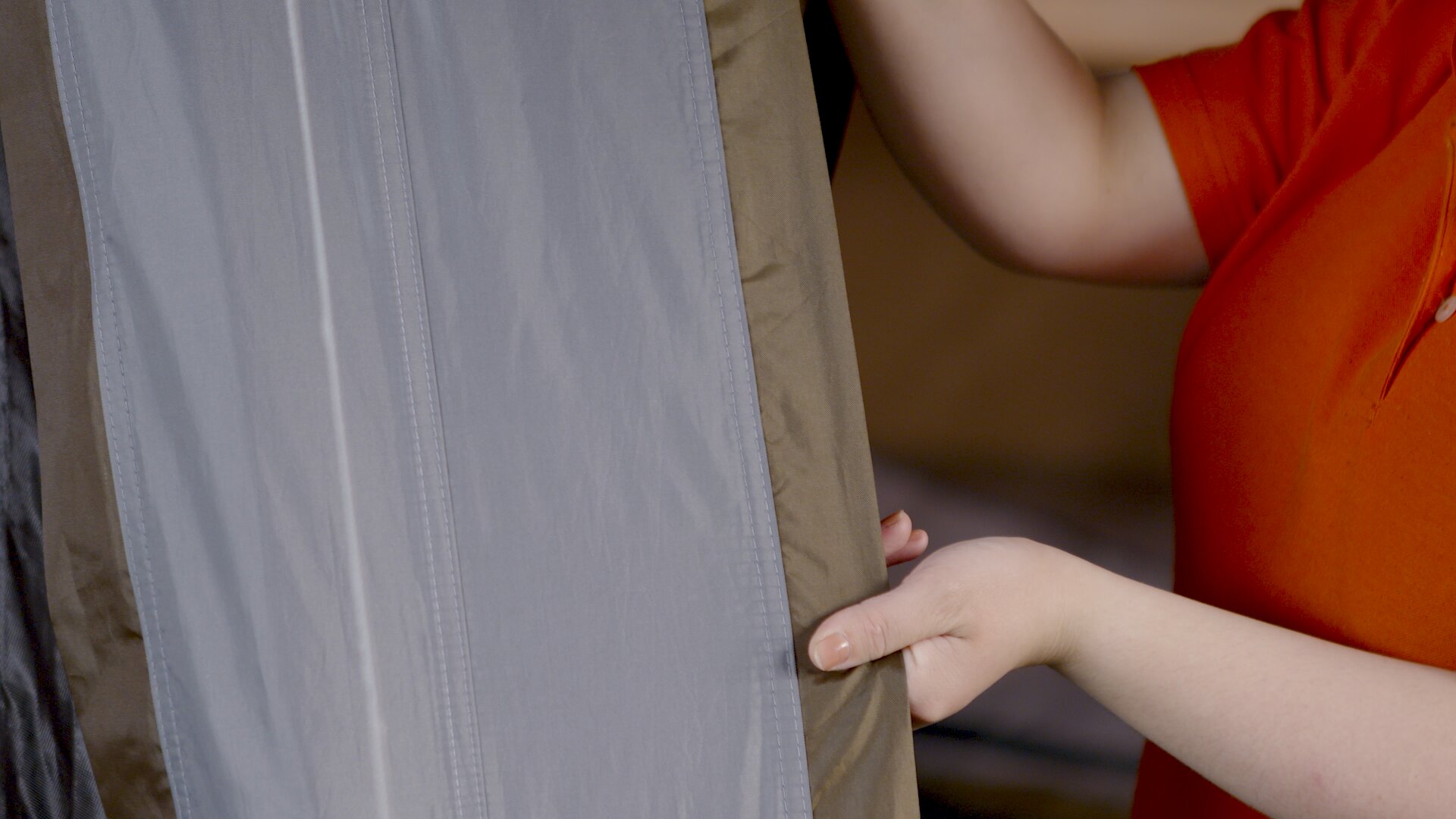
| Benefit | Sleeves | Clips |
| Fastest Set up/pack down | X | |
| Best airflow/less condensation damp | X | |
| Sturdiest tent structure in strong winds | X |
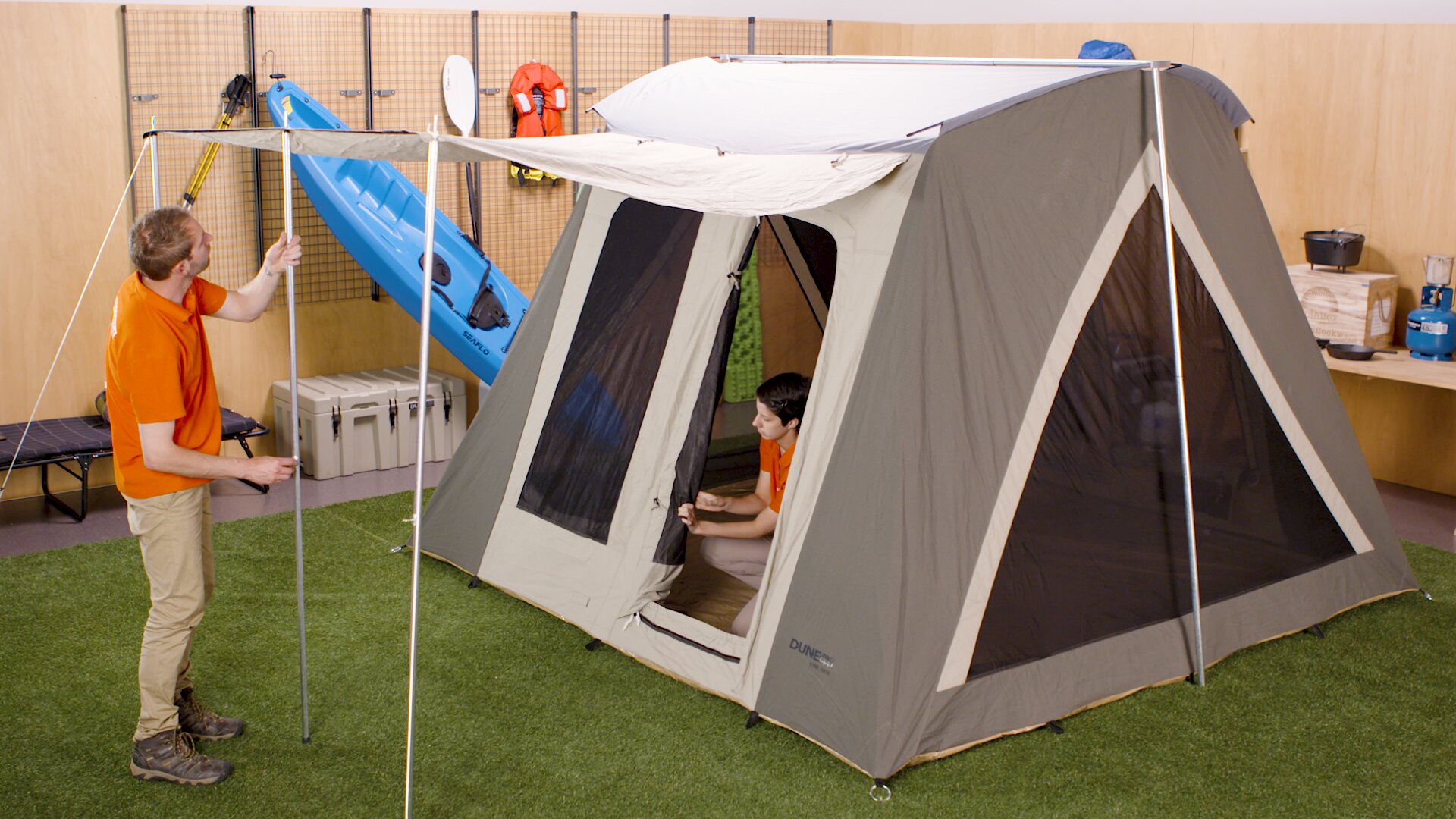
Ropes
Also known as guy ropes or guy lines, the tent ropes attach the fly to the ground pegs:
- The fabric tension drains rain water away from your tent.
- The stability keeps your tent securely fastened when it's windy, raining or snowing.
Anyone who's been camping has probably tripped over tent ropes, so some tents have glow in the dark or reflective ropes to help keep all your campers safe.
Vestibule
A covered porch or living space that's attached to the front or side of the tent:
- Gives you more space to store gear that you want to protect from the elements.
- Even small tents have small vestibules so you can keep wet, muddy gear outside to dry overnight, which keeps the inside of your tent clean and dry.
- Having a two-door tent with two vestibules (one over each door), gives you more space for storing wet gear overnight.
Pockets/Hooks
Some tents have:
- Pockets on the inside to help you keep little things organised and within easy reach, like phones, torches and toilet paper.
- A hook on the tent ceiling that's handy for hanging a light or a washing line.
Floor
If the floor has a hole in it, it's no longer waterproof and you'll need a whole new tent:
- A good, durable flooring material keeps water out and means your tent will last.
- A bucket or bathtub floor extends up the sides of the tent, giving you extra waterproof protection because it stops water seeping in during heavy rain.
- Putting a 'footprint' (usually sold separately) or a tarp under your tent gives it an extra layer of protection from rain, as well as foot traffic and rocks that can put holes in your tent floor over time, so the floor and tent last longer.
Tent Bag
Packing the tent back into the bag can be tricky, so a slightly bigger tent bag:
- Makes it easier to fit everything back in the bag.
- Helps with airing the tent as well.
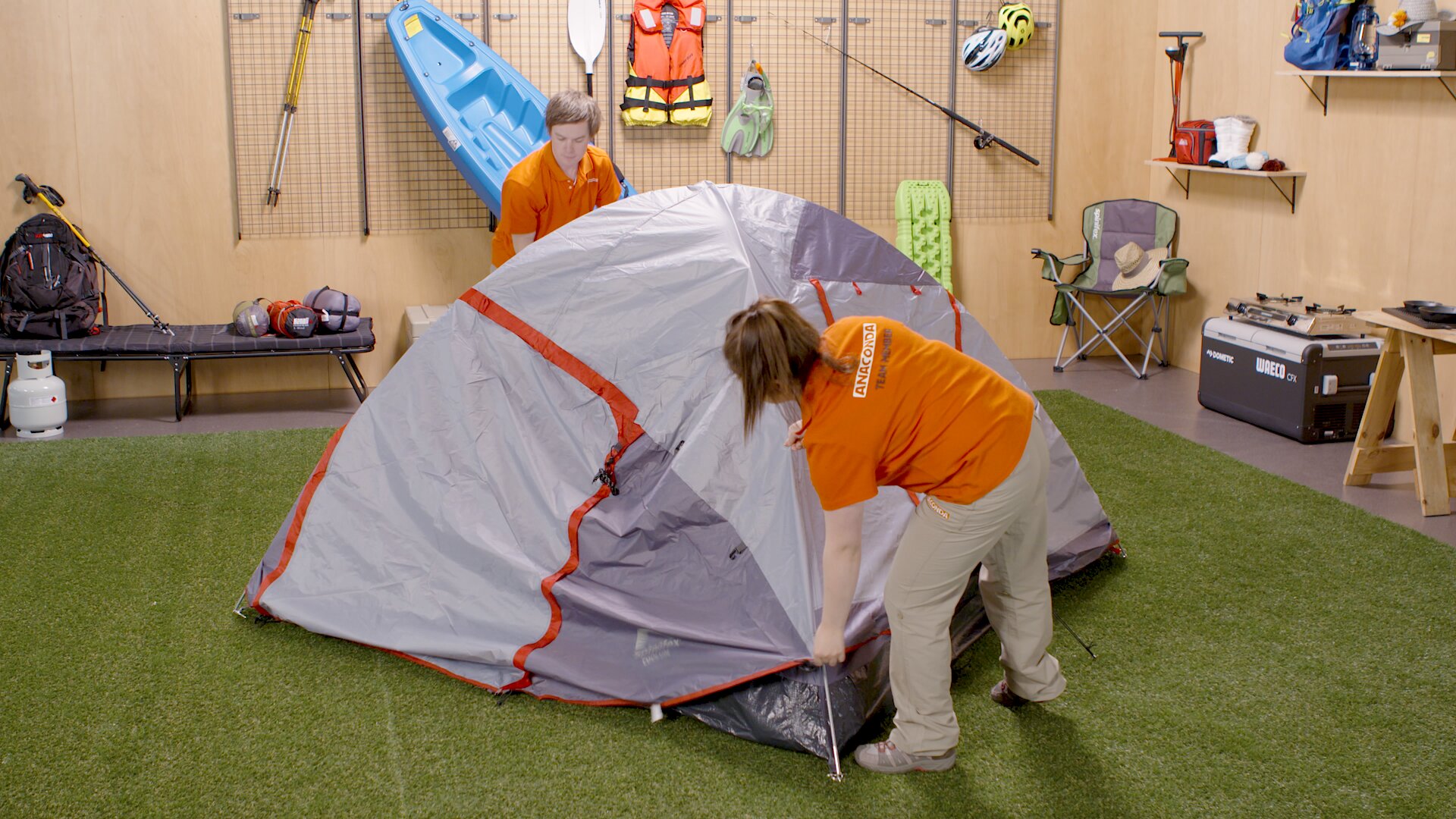
5. Types
In addition to their size (e.g. a two-man tent), tents are described by their shape or use.
Ridge Tents
Ridge tents are a simple sleeping shelter.
Ridge tents are:
- A traditional, triangle-shape and they're popular with Cub Scout groups
- Created with two vertical poles at each end and a horizontal pole in the middle
- A simple sleeping shelter because the sloping walls make the space inside small
- Usually have a nylon or polyester fabric
Dome Tents
Dome tents give you more head height.
Dome tents are:
- The most popular type of tent
- Able to withstand bad weather
- Easy to set up and pack down
- Much lighter than cabin tents
- Made in small and large sizes (some have separate rooms)
- Usually have a polyester fabric
- Shaped like a dome thanks to flexible poles that bend
- Sometimes high enough in the middle to stand up in
- Available in three structural styles:
- Crossover (the poles crossover)
- Pure (just two hoops)
- Geodesic (crossover poles plus two hoops
Geodesic Tents
Geodesic tents are a sturdy dome for extreme conditions.
Geodesic tents are:
- The sturdiest type of tent for extreme expeditions
- Able to withstand heavy snow and mountain winds
- Set up with crossover poles and side hoops
- Heavier and harder to set up than other dome tents
- Usually made from nylon or polyester
Cabin Tents
Cabin tents are high enough to stand up in.
Cabin tents are:
- A popular tent shape for families
- Large inside thanks to their vertical walls
- Assembled from a hard-pole frame
- Designed to create cabin-style spaces
- High enough for people to stand up in
- Usually big enough to fit a table and chairs
- Homely and some have different rooms
- Reliable and long-lasting
- Usually made from canvas fabric
Teepees
Teepees are popular for festivals and glamping.
Teepees are:
- Simple to set up
- Popular at festivals
- High enough to stand up in
- Usually made from canvas fabric
Pop-up Tent/Instant-up Tent
Pop-up tents just pop up in a minute or two so they're super easy to set up.
Instant up tents are:
- The easiest to set up - it only takes 1-3 minutes
- Designed with poles inside the fabric
- Just pop ped out then pegged into the ground
- Popular with inexperienced campers
- Sturdier than they used to be
- Sometimes able to withstand three seasons
- Usually made from nylon or polyester
Family Tents
Family tents are designed for family camping trips.
Family tents are:
- Designed to fit the whole family
- Either cabin tents or dome tents
- Sometimes divided with curtains or walls for privacy
- Sometimes tricky to set up due to their larger size or when it's windy
Hiking Tents
What is a lightweight hiking tent? The Denali Vortex III Hike Tent is spacious and only weighs 3.4kg so it's easy to carry.
Hiking tents are:
- Extremely light and compact
- Easy to carry while you walk
- Designed for 1-3 people
- Usually made from nylon or polyester fabric
Want to know more about what to look for in a hiking tent?
Make sure you read the:
Swags
Swags are a compact tent-alternative that sleep 1-2 and simplify camping.
Swags are:
- Popular for camping and 4WDing
- Only 1m high so they're a simple sleep space
- Designed for one or two people
- Comfortable because most have a built-in mattress
- Made from long-lasting, waterproof, insect-proof canvas
- Easy to set up - just roll it out
- Sturdy enough to handle rain and wind
- Warm in winter and cool in summer
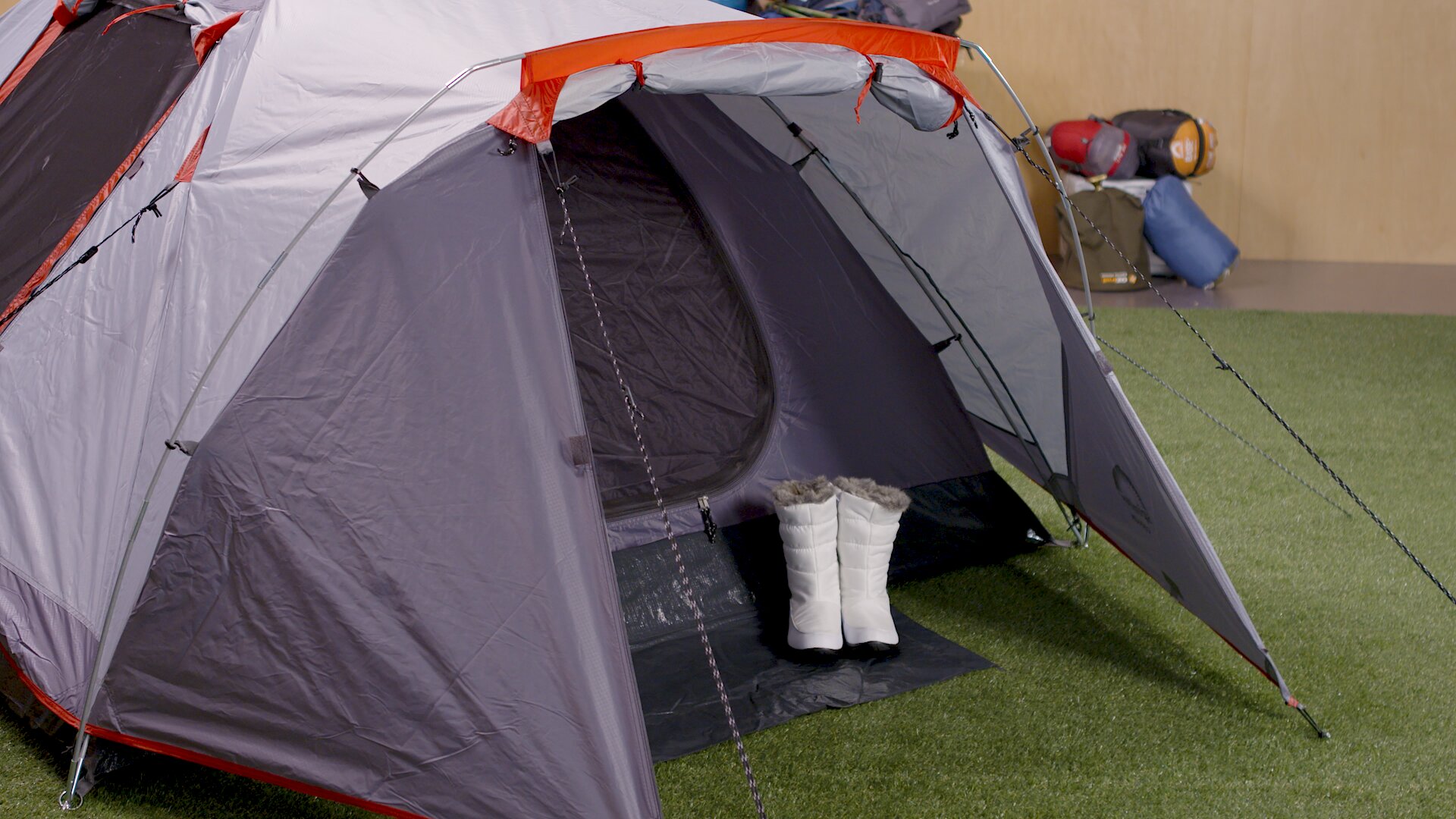
6. Quality
When you're weighing up which tent to buy, think about quality versus cost:
- Nylon tents are the cheapest but they won't last as long as other fabrics
- Dome tents are usually cheaper than cabin tents
- Geodesic tents are the most expensive but essential in extreme weather
When it comes to how much you should spend on a tent:
- If you just want a tent the kids can play with in the backyard, a cheap tent should do the trick.
- Cheaper tents tend to be less waterproof than tents that cost more, so you get what you pay for.
- If you want comfortable camping trips for years to come, it's worth spending a bit more on a good-quality tent.
- Think of it this way, whatever you spend on a tent, you're saving on future holiday accommodation because you can camp instead.

How much are camping tents?
Anaconda tents range from $30 to $2050, and the majority of Anaconda's camping tents are $50 to $400.
When you go to the tent section on the Anaconda website, you'll see tick box filters down the left hand side of the page. Using these filters makes working out which tent to buy easier and faster because you can choose to filter the tents you see by their:
- Price - so you only see tents that are within your budget on the page
- Deal - so you only see all the tents that are on sale or at clearance prices
- Categories - so only tents specially designed for hiking or families are shown
- Sleeping capacity - so you only look at tents that suit your camping numbers
- Size - so you can see which tents will suit the size of the bed you want to use
- Brand - so you can find specific brands like Coleman tents that have Dark Room™ technology and a Weather Tec Weather Tec system that keeps water out and campers dry.
Other Camping & Hiking Essentials
Check out Anaconda's range of Camping & Hiking products available online or visit your local store.